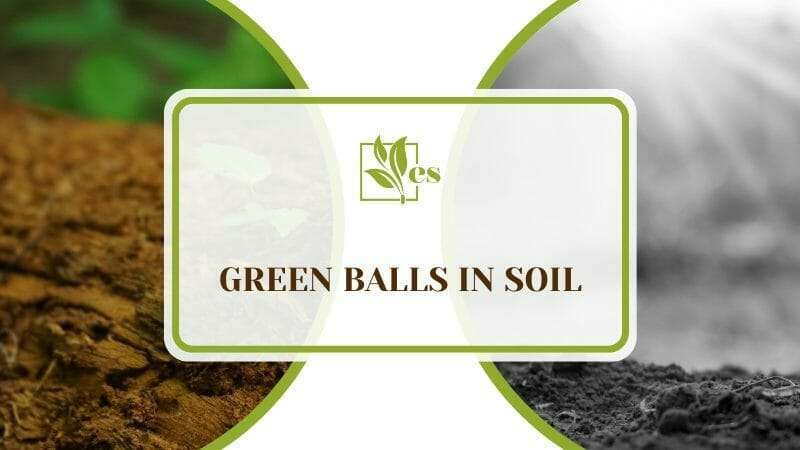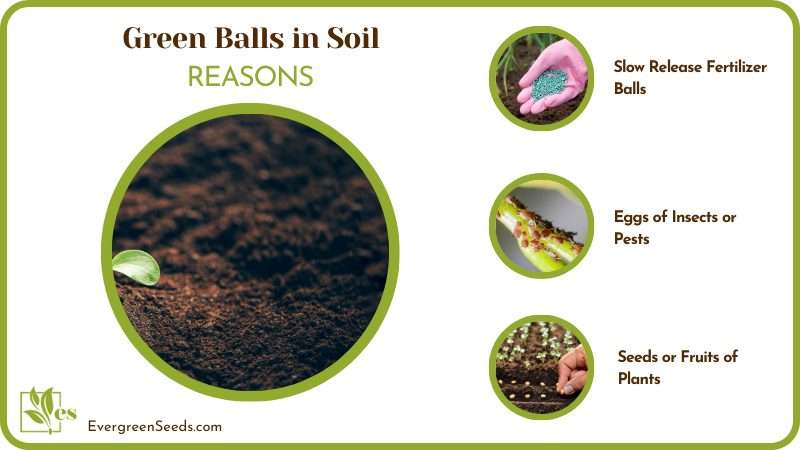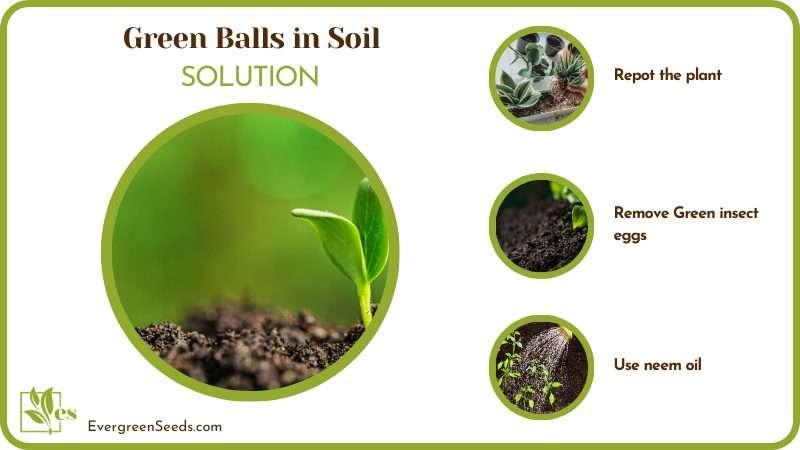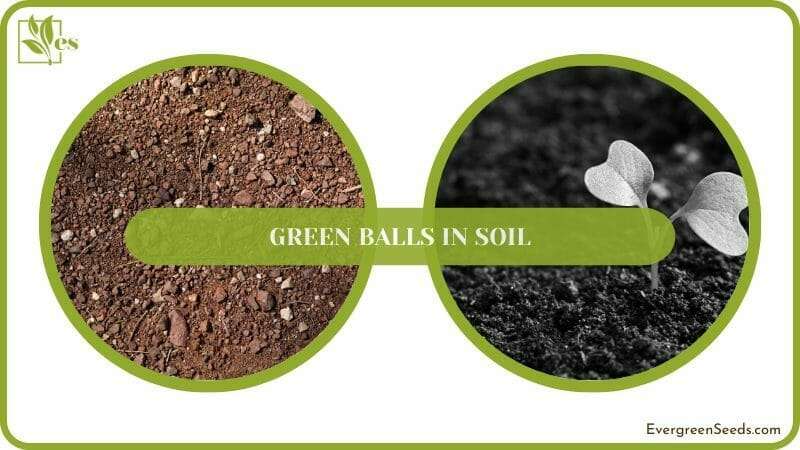If you have concerns over green balls in soil of your potted plant, you don’t have to immediately worry as these can just be harmless substances.

In this article, we will take a look at these small green balls and our experts will tell you how to identify them to know if they are harmless or not. Read on to know more about these small green balls in soil.
JUMP TO TOPIC
What Are the Green Balls in Potting Soil?
Green balls in potting soil can be insect eggs, fertilizer balls or fruits. If you have spotted tiny green balls in the soil, we will help you identify them below. Read on to know more.
– Slow Release Fertilizer Balls
The tiny green balls in soil can most likely be slow-release fertilizer pills. Granular-looking slow-release fertilizer balls serve the purpose of supplementing the soil’s nutrients. They are not water-soluble like liquid fertilizers.
Slow-release fertilizer balls are present in nursery plants. They come already mixed in the potting soil to aid the growth of the plant, and they remain on the surface of the soil (regardless of the type of soil you use) looking like little green eggs.
Don’t worry, these green balls do not harm your plant in any way. Instead, they promote the growth of the plant by releasing nitrogen, phosphorus, potassium and other good nutrients. Biodegradable and small, they consist mostly of vegetable oil and polymer resins.
– Eggs of Insects or Pests
On several occasions, the green eggs in the soil can be the eggs of various insects or pests. You can distinguish between fertilizer balls and insect eggs by checking the size and surface of the green ball. You will find that fertilizer balls are harder and larger than insect eggs.

– Seeds or Fruits of Plants
On some occasions and depending on the plant, the small green balls can also be fruits or seeds that may have fallen or been dispersed from other plants. To determine if it is a seed, squeeze it out in its entirety.
Remember to wear protective gear such as gloves before you get started. Potting soil may consist of harmful compositions.
How Do Slow-release Fertilizers Work in Your Soil?
Fertilizer pellets are slow-release fertilizers, like the 0-0-60 fertilizer, added to improve soil nutrition. These are best-loved by nurseries because it lowers their labor costs. Green in color, the pellets release fertilizer slowly into the soil.
The coating of these pellets released depends on the temperature conditions and not by the presence of water. The hotter it gets, the quicker the fertilizer will leach into the soil. The pellets dump their load at the fastest rate at high temperatures. During the cooler winter months, the green fertilizer balls do not release any fertilizer at all.
Slow-release pellets prove helpful in areas that are subject to erosion, such as terrace farming or slopes. Having slow-release pellets in a potted plant can also bring several disadvantages.
The rate of release of the fertilizer may be way too slow in comparison to the plant’s needs, and slow-release fertilizers are more expensive than soluble fast-release fertilizers.
Are the Green Balls in Potting Soil Harmful to Plants?
Depending on what they are, these green balls may or may not be harmful to plants. It is thus important to identify them as soon as you spot them.
– Green-fertilizer Balls Are Not Harmful
These kinds of balls are slow-release fertilizers that boost the potted plant with nutrients. They nourish the plants and provide needed substances. Green-fertilizer balls take two years to degrade completely, so until then you will find them scattered across the surface of the soil. One good example is the 46-0-0 fertilizer that can be used with trees, vegetables, and houseplants.
– Green Insect Eggs Can Be Hazardous
Your potting soil could be harmful or hazardous to your plant if you have identified them as insect eggs. These can eat into your plant once they hatch into larvae, so remove these eggs as soon as you spot them.
How Do You Test Green Balls in Soil To Tell What They Are?
There are several ways to find out what the small green balls in the soil exactly are. There are visual differences and there are textural variations. With keen observation, you can find out if it is slow-release fertilizer balls, seeds or eggs.
– Determining Green Fertilizer Balls
Slow-release fertilizer balls are green in color. They are spherical with a hard outer coating. You will usually find fertilizer balls spread out all across the soil.
The easiest way to determine if they are fertilizer balls is to squeeze them. They will crack when pressed and release a semi-solid discharge, which is the salt composition present in it.
Slow-release fertilizer balls are beneficial and not at all harmful to your plants.
– Determining Green Insect Eggs
Eggs of pests can look green and similar to fertilizer balls. They have a softer outer covering and are squishy to touch. The goo-like insect eggs are oval and elongated.
Insect eggs are smaller than green fertilizer balls in potting soil. They remain localized and concentrated in a single location, so you can find them in cool and shady places under the plants.
Eggs found in potting soil often come from worms, ants, ladybugs, weevils, snails or slugs.
– Determining Fruits or Seeds
Unknown green balls in potting soil can also be seeds, fruits or mold. To identify them, squeeze the fruit or the seed. You will be able to squeeze the fruit out in its entirety and also be able to see the inside parts of it.
Remember to wear protective gear like gloves before you start investigating green balls in soil.
Getting Rid of Green Balls in Soil
Here are several ways to get rid of green balls in soil. Once you figure out the type of green ball in your potting plant, you are now also aware of whether it is harmful or not. To safeguard your plant, it is important to remove the balls that are going to hamper the growth of your plant.

– Fertilizer Balls
As fertilizer balls cause no threat to your plant, do not remove them. Let them stay in the soil to keep your plants happy.
Slow-release fertilizer balls take two years to decompose into the plant soil. The rate at which they decompose depends on the increase in temperature, but rain and watering also make them disintegrate faster.
Until then, you are going to spot them around your potting soil. Removing them can deprive your plant of required nourishment, so let these fertilizer balls stay in your soil.
– Insect or Pest Eggs
Green insect eggs can be a great threat to your plant. Not only do they damage roots and soil, but they can also stay on the plant’s leaves. Once they hatch, the larvae can then eat up leaves, flowers and tender shoots.
– Removal
It is advisable to remove any insect or pest eggs as soon as you spot them. For insect eggs found scattered on the soil, the best thing to do is repot the plant. Remove the plant from the affected soil and change the entire potting mix. Take care not to damage the roots in the process.
For insect eggs spotted on leaves or the base of the stem, blast them with water mixed with organic sprays. You can use an organic spray such as neem oil. A blast of this mixture will help remove the eggs from a large area.
Make sure that you cover the underside of leaves and growth. Spray in the morning hours so they can dry out and fall to the soil. You will need to check after three days for the remaining eggs, and if they are not fully removed, repeat the spraying process. As a precautionary measure, make sure to wear gloves before you engage in removing the eggs.
– Dispersed Seeds or Fruits
If the green balls found in your potting soil are seeds or fruits, it is still wise to remove them. Though they do not cause much harm, seeds or fruits in the soil can grow into unwanted weeds.
Aside from being unsightly for your garden, these weeds may soon fight for the same space and nutrition as your potted plant. With this in mind, pick out every such seed or fruit as soon as you spot them.













